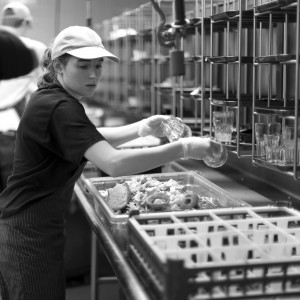
The upstairs dish room in Anderson Commons hums with the sound of running water and machinery. Three student workers stand in front of two clear plastic bins that are filling up with a medley of foods left over from their classmates’ plates. The students are told to empty drinks into the trough in front of them and to throw away banana peels, paper products and apple cores. Everything else from leftover conversation hearts found at the bottom of a coffee mug, to a full slice of pizza is considered food waste and is scraped off or dumped into the bins.
Professor Joan Kopperud and her IWC class participated in the annual plate waste study, done by Dining Services twice a year, on February 18 and 19. Kopperud thought the plate waste study was a great opportunity for her students, especially since her class focuses on food and food related issues.
The students worked with Concordia’s Dietetic Interns, Laura Croteau and Nicole Ralston, and were expected to observe at least 10 meals at different times of the day, documenting the food waste habits of their friends.
After the study was complete, and the interns had finished the statistical analysis of the amount of food waste, the students were to utilize their experience, the results of the study and information they got from interviews with the interns to write two essays.
Cindy Hogenson, assistant director of Dining Services, started at Concordia in 1999. Once every spring and fall, Dining Services conducted the plate waste study to help better their services and improve food sustainability. However, Hogenson said in recent years, student involvement has brought a new element to the study.
“In the recent years we have seen more inquiries and more action being taken by student groups and in classrooms,” Hogenson said. “It provides a more effective way to get information to student customers, and students relate better to their peers.”
This year, with the involvement of Kopperud’s class, Croteau and Ralston found the total pounds per day was 129.125 pounds on Wednesday and 110.75 pounds on Thursday. Both days added up to 239 pounds and 14 ounces.
In an effort to help the students understand further the amount of waste that was produced, Croteau and Ralston did some comparisons. An apple weighs 182 grams or .4 pounds. Multiply that by the 238 pounds produced over two days and it equals to 594 apples wasted.
Before presenting this information to Kopperud’s class, Croteau and Ralston wanted to see what the students had guessed was the average amount of waste.
“The average guess within the class was 50-70 pounds,” Croteau said. “When one student guessed 200 the other students didn’t believe him.”
When the students were given the real results, Croteau described that class as flabbergasted, awe struck, and with gaping expressions.
Amarachi Nasa-Okolie, a student that participated in the study was already aware of wasteful American eating culture. She is from Nigeria and at home they don’t experience food waste in the same way Americans do.
“Ive always thought American eating culture was absurd…weird and different,” Nasa-Okolie said. “Americans are very wasteful in how they deal with their food and the experience [with the study] enhanced that perspective.”
Joel Carter, also a student in Kopperud’s class, agrees that the plate waste in Dining Services isn’t just about the college, but is a cultural issue.
“I always knew as a nation we tend to live in excess with the common mindset ‘why have one when you can have two?’” Carter said. “Just because [we have] an abundance doesn’t make it okay to waste what we do have.”
The plate waste study is a multistep process. Before they could start gathering data on the amount of plate waste, Croteau and Ralston had to prepare the containers they would use to hold the food. According to Ralston, they started by weighing the clear tubs on a scale and created sheets of paper to label each bin.
For each hour the students would work, there would be two bins.
The bins were then brought to upstairs dishwashing room where one to four of Kopperud’s students, dressed in long tie aprons and with their hair tied back, would simultaneously scrape food off the plates into the bins, squeeze left over condiments into the bins and stacked glasses in trays.
Filling the bins with leftover food did not appear to be too difficult. The dish room was filled with the clinks of black and white dishware and pieces of the students’ conversations. With gloved hands they used silverware to scrape pieces of egg, or pasta that would have been just a mouthful more.
Croteau yelled out, “Is that meatloaf or ribs?” as a full plate of meat came by on the conveyer belt. If it was ribs, they would have to pick the meat off of the bones to put in the bins and throw the bones away.
Followed by that was a full slice of pepperoni pizza, half a waffle, a burger with one bite taken from it and a full bowl of snicker salad.
During her shift in the dish room, Nasa-Okolie experienced the same amount of waste, including in paper products. At one point, she said a student became creative with the napkins they had left.
“I worked 10:30-11:30, and the amount paper waste products I saw was surprising. One student stuffed a lot of paper in a banana peel to make a whole banana again.”
As the hour hit around 12:30 p.m., plates full of food began to pile up and the amount of waste appeared to double. The students had to alternate grabbing plates, furiously scraping food and separating waste from garbage, while the interns occasionally helped and switched out the full glass trays with empty ones. The busier it got, the fuller the plates became as if students were too busy to finish food or too hurried to pay attention to their serving size.
Normally when plates come around, the student workers and staff usually scrape the food waste into the trough in front of them, but Croteau had to teach them what was considered waste, belonged in the bins.
“Milk in a cup was not food waste but in a cereal bowl it was,” Croteau said. “If an apple looked like it was impossible to eat, then it wasn’t waste, but if it had a few or no bites then it was.”
After the food waste was collected and weighed, Croteau said it was put in the pulper, which grinds up the food into small pieces, and it was taken to a landfill.
Despite her awareness of American food waste, it was still a shock to Nasa-Okolie to observe her classmates’ wasteful habits.
“It was an experience. A journey, kind of, to encounter the amount of food waste per person,” Nasa-Okolie said. “You don’t realize how much you waste as a community.”
Even though the purpose of the students participating in the study was to fill a requirement for their IWC class, they learned a lot more than what was expected, and their involvement shed a new light on the plate waste study. For Carter, he did not know what to expect when he arrived at his shift in the dishwashing room.
“It was a new experience,” Carter said. “I was told how to sort cups and what was considered waste and got the hang of it.”
Carter began to realize just how bad the plate waste was.
“I knew there was food waste but I didn’t know it occurred with such a large scale,” he said. “Some food looked like it had been played with rather than eaten.”
During the study, Ralston came across a plate that had two chicken sandwiches, one had only been half eaten and the other looked untouched. She also came across a plate with two full rib sandwiches. She left that plate to be discovered by one of Kopperud’s students.
Croteau was excited by the students’ angry reactions.
“To see students get fired up helps them make a change,” she said.
The waste issue does not appear to depend on the food being served, but the eating habits of the students, according to Ralston.
During the study, Croteau and Ralston also were able to determine the amount of waste per student.
The total average waste per student on Wednesday was 2.32 ounces and the average waste on Thursday was 2.1 ounces.
“It’s important to know that roughly 800 people swiped in each day,” Ralston said. “That equals about 110 pounds for 800 people. I want people to realize even though its a small amount to them, in the big picture, it is more.”
Most individuals consume 4 lbs of food per day, according to Croteau. The amount of waste that was gathered within the two days was enough to feed 59 people for a whole day.
Kopperud agrees it is important for students to realize their actions affect more than just themselves and impact the world around them.
“Students come to DS, eat their food and if they don’t want something they put it on the conveyer belt and it disappears,” Kopperud said. “Students need to see their surroundings. They don’t realize [their] actions are a part of a much larger chain of food relations and decisions of sustainability.”
Although it is evident that plate waste is a large issue, Croteau does not think it is inevitable. There will always be some, but it is something that can be helped.
“Plate waste isn’t just the waste that the [students] wasted,” Croteau said. “There is time put into making that food and transportation needed to bring the food here. After the food is wasted people have to pulp it, pay the dishwashers, come and pick up the food and take it to a landfill. There is so much more to it than a lot of people see.”
Over the years, plate waste studies have been conducted at Concordia, and through 2010, the numbers have been pretty consistent Croteau said.
Hogenson said Dining Services does the plate waste studies and monitors the information to look for trends or changes that might indicate a decrease or increase in customer satisfaction. Dining services also compares their information to other colleges to and try to find out if there is a different style of dining service at other colleges and if that produces better results.
“One thing we try to do is make the serving sizes smaller, like the desserts so students can take as little as they want,” Hogenson said. “We also maintain information here and readily share it to student or campus groups to promote plate waste and 100 percent consumption of food students take.”
Despite the strong efforts of Dining Services to help combat the amount of food waste, Hogenson said the ultimate solution is for the customers to think about what they are putting on their plates.
“We can do the things we can in DS to encourage not having trays and having small portions, but it is ultimately up to the customer to take responsibility in how they eat,” Hogenson said.
Ralston believes that one way to get students to think about what they are putting on their plates is to put something at each food station to generate some thought, however she is not sure what that would be yet.
Having done the plate waste study and experiencing first hand what plate waste looks like, Nasa-Okolie said that making the plate waste study a communal thing would help bring awareness and motivate others to change their eating habits.
“I think it should be important for everyone to do the plate waste study. Every class, department, major should participate because they have to see for themselves what they are doing,” Nasa-Okolie said.
Nasa-Okolie also believes that Dining Services should go a step further than going trayless like they did in 2009. In Nigeria, the size plates they use are similar to the small black plates used in Anderson Commons, which makes them get smaller portion sizes and ensures they finish their food Nasa-Okolie said.
“Dining Services should reduce the big white plates and use small black plates, so people can … make their eyes the same portion as their stomachs,” Nasa-Okolie said.
If the students are still hungry while using the small black plates, Nasa-Okolie said they could go for seconds, but they would be less likely to waste any food.
Carter believes that simply educating the public would help the student body understand what plate waste really means for them and those affected by it.
“If people were more aware of what goes on behind the scenes maybe it would influence them to think about portions and ‘How hungry am I? ‘ It gave me a new perspective on food waste,” Carter said. “Knowledge is power. The more people know about [food waste], the better chance we have to help this problem,. It won’t be totally eradicated but if we can reduce the amount of plate waste, that is something in our control.”
As the observation shifts come to an end, Ralston hopes their time in the dishroom made a lasting impact.
“They [the students] needed to scrape the plates to learn something.” Ralston said.

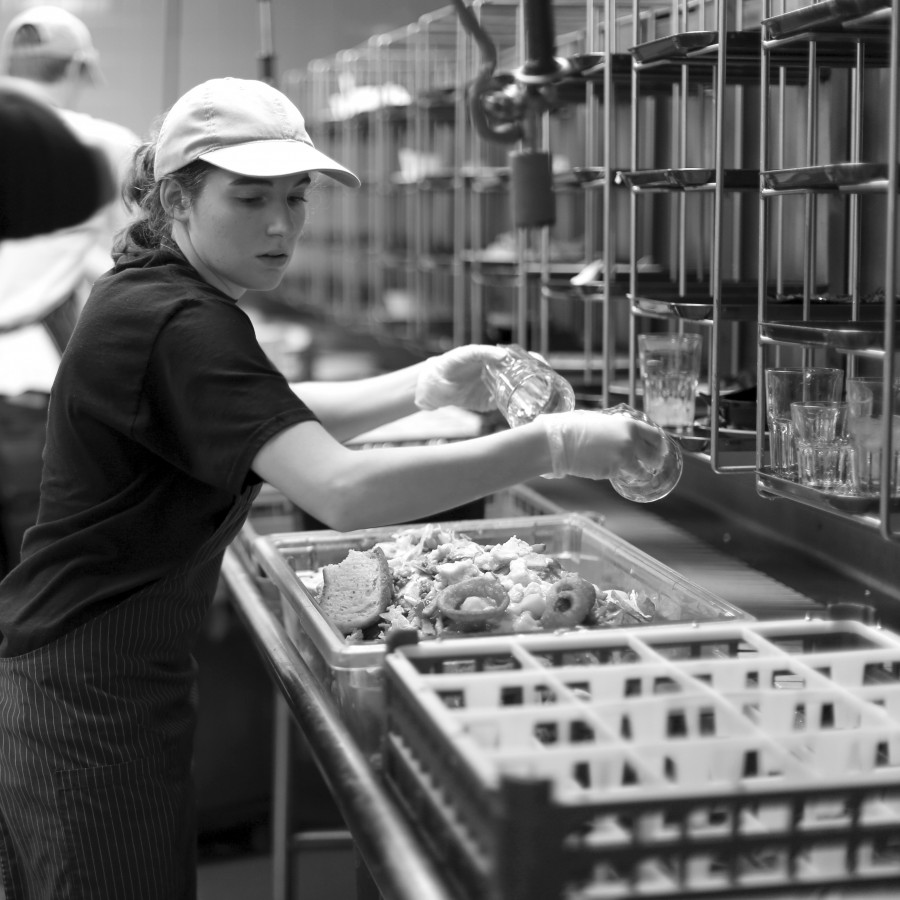
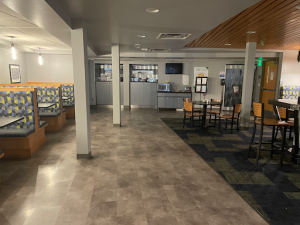
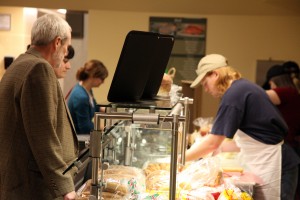
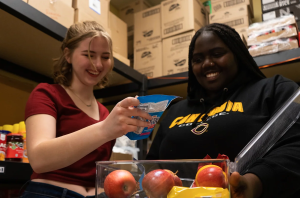



Be First to Comment